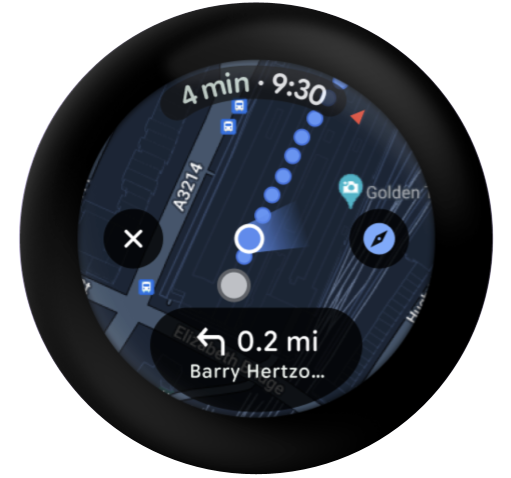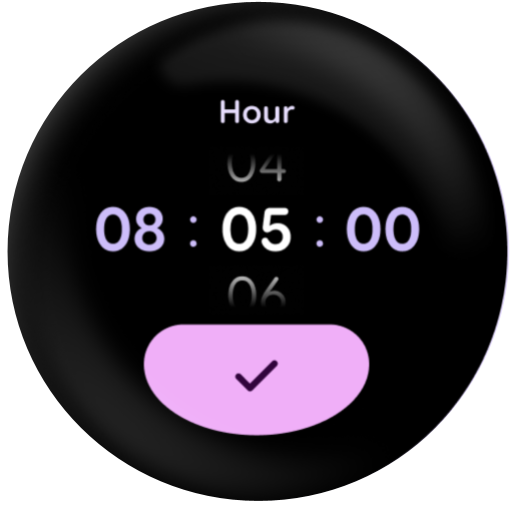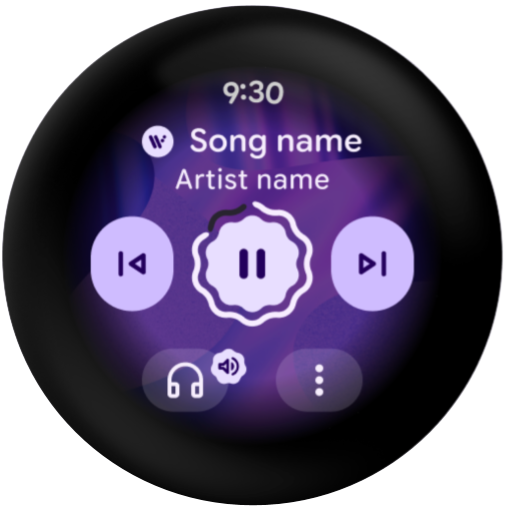אפליקציה היא תצוגה ממוקדת שמטפלת במשימות מורכבות מדי בשביל סיבוך, משבצת או התראה. אפליקציות ב-Wear OS דומות לממשק המשתמש הראשי של אפליקציה לנייד. אפשר להשתמש בממשקים כמו אריחים, סיבוכים והתראות כדי לבצע משימות, אבל כדי לבצע משימות מורכבות יותר צריך לקשר את הממשקים האלה לאפליקציה.
כדי להבין טוב יותר את האפליקציות, כדאי לקרוא את העקרונות ואת תרחישי השימוש הבאים.
עקרונות UX
כשמעצבים אפליקציות, חשוב להביא בחשבון את העקרונות הבאים:
מיקוד
התמקדות באפליקציות למשימות קריטיות כדי לעזור לאנשים לבצע משימות תוך שניות, וכך למנוע אי נוחות ארגונומית או עייפות בזרועות
שטוח ולינארי
מומלץ להימנע מהיררכיות עמוקות יותר משתי רמות. הצגת הניווט בתוך השורה
גלילה
אפשר לגלול בתצוגות. זו תנועה טבעית שמשתמשים עושים כדי לראות יותר תוכן בשעון
מתי כדאי להשתמש באפליקציה
כדאי להשתמש באפליקציות במצבים הבאים:
מידע נוסף
כדאי להתמקד באפליקציות שמבצעות משימות קריטיות כדי לעזור לאנשים לבצע פעולות תוך שניות, וכך למנוע אי נוחות ארגונומית או עייפות בזרועות.

אינטראקציות עשירות יותר
כדי לספק אינטראקציה עשירה יותר מאשר סיבוך או אריח.

לפעילויות ארוכות
כדי לתמוך בפעילויות ארוכות טווח כמו אימונים והפעלת מדיה.

פיתוח אפליקציה
Jetpack Compose היא ערכת כלים מודרנית להצהרת ממשקי משתמש, והיא הגישה המומלצת לפיתוח אפליקציות ב-Wear OS.
ברוב המקרים, ממשקי משתמש שנוצרו באמצעות Jetpack Compose כוללים פחות קוד ומזרזים את תהליך הפיתוח של אפליקציות ל-Android באופן כללי. מידע נוסף על היתרונות הכלליים של מסגרת הצהרתית לממשק משתמש מופיע במאמר למה כדאי להשתמש ב-Compose.
Compose for Wear OS פועל לפי עיצוב Material 3 Expressive, כולל נגישות מובנית ומטמיע עיצוב Material, שמאפשר לכם להתאים אישית את העיצוב למותג שלכם. Compose for Wear OS נועד לעזור לכם ליצור חוויות משתמש שתואמות להנחיות העיצוב של Wear OS.
מדריכים ליצירת אפליקציות באמצעות Compose ל-Wear OS
כדי ליצור את חוויית המשתמש הטובה ביותר באמצעות Compose for Wear OS, מומלץ לעיין במדריכים הבאים:
- שימוש ב-Jetpack Compose ב-Wear OS: מידע על פיתוח באמצעות Compose ל-Wear OS.
- יצירת רשימות: איך יוצרים רשימות שממוטבות למכשירים לבישים.
- ניווט באמצעות Compose ל-Wear OS: מידע נוסף על יצירת ניווט ב-Compose
- טיפול בקלט סיבובי ב-Wear OS: מידע נוסף על טיפול בקלט סיבובי ב-Wear OS.
- תמיכה בגדלים שונים של מסכי מכשירים : כאן אפשר לקרוא איך לוודא שהאפליקציה תפעל בצורה טובה במכשירי Wear OS בכל הגדלים.
- ביצועים של Compose ב-Wear OS: מידע נוסף על ביצועים ועל בדיקת הביצועים של האפליקציה

